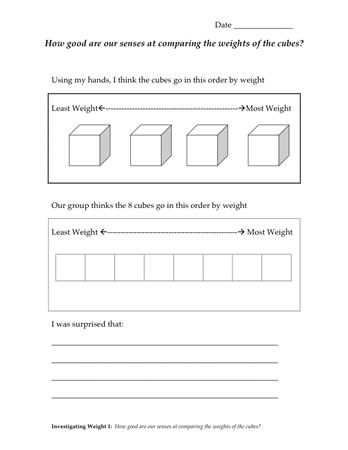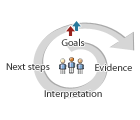How good are our senses at comparing the weights of the cubes?
Plan Investigating Weight 1
Children, being small, can be quite good at gauging weights. If they weren’t, they’d struggle under many heavy burdens. In this investigation, students explore how well they can compare weights using only their hands.
Formative Assessment
Available online at inquiryproject.terc.edu
Students first talk about evaluating weight with their senses. Working in groups, they then try to put the materials cubes in order using only the “felt weight” in their hands. When they see that different groups arrive at different orders, they consider the limitations of felt weight.
By the end of this investigation, students will see that they cannot always rely on their senses to compare weights. Some may suggest using some sort of “scale.”
Learning Goals
- to understand the limitations of “felt weight”
| Sequence of experiences | ||
|---|---|---|
| 1. Ask the question | All Class | 10 Mins |
| 2. Explore sensed weight | All Class | 5 Mins |
| 3. Order four cubes by felt weight | Pairs | 10 Mins |
| 4. Order eight cubes by felt weight | Small Groups | 10 Mins |
| 5. Make meaning | All Class | 10 Mins |
Materials and Preparation
For the class:- Post the investigation question in a place where all students can see it.
- Make a table on a whiteboard or flip chart to record students’ orderings of the cubes; an example can be found in Step 4.
- Try ordering the cubes by felt weight yourself; it’s harder than it looks.
- 3 objects that appear identical but have clearly different weights, e.g., 3 boxes of chalk containing different numbers of pieces or 3 salt shakers filled with different amounts of salt
- One pan balance
- 1 set of cubes with the names of the materials on the cubes
Notebook Pages
Can students use class data to answer the question, "How good are our senses at comparing the weight of cubes?"
You can find evidence by listening to students discuss and make meaning of the class data. Each group has posted their list of cubes ordered by "felt weight." There is agreement and disagreement.
As Joan interprets the points students make, she listens for students to:
- Identify instances where there is agreement on the weight order of the cubes (not seen in video) and where there are discrepancies (copper and steel).
- Note that these data make it difficult to support an unqualified claim (Our senses are good as long as cube weights are quite different, or if the cubes aren't very light or very heavy.).
After they hear evidence for both positions, give students a chance to change their position as a next step.
1. Ask the question
Let students know that for the next four sessions they will be investigating weight. They will compare the weights of different things, including their materials cubes, and they will learn different ways to measure weight.
First explore students’ prior experience and understanding of weight:
- What is weight, anyway?
- What do you think is the heaviest object in this classroom? Why do you think so? How about the lightest one?
- How can we measure weight? What instruments for measuring weight have you seen or used? (Students might mention a bathroom scale, a doctor's scale with moveable weights, a hanging spring balance in the produce department, or perhaps a truck scale on the highway.)
- Are objects always measured in pounds?
Share the investigation with the class:
Tell students that their work today will help them start to answer this investigation question, but that they’ll not get a complete answer until after the next class class.
Note: In this session students will compare their sense of “felt weight” with that of others in the class. In the next session they will establish a weight order using a pan balance. Only then will they know how accurate their “felt weight” orderings are. Don’t tell the students about the pan balance at this point, but let them know that scientists usually work for a very long time before they can answer their own questions.
2. Explore sensed weight
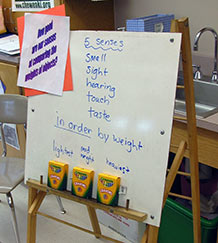
Use the three objects that appear identical but have different weights:
- What if we wanted to order these objects by weight, from most weight to least weight, and all we could use was our sense of sight? Could we do that?
- Could hearing help us? How?
- What about touch?
Listen for student ideas about weight and how a person can tell what something weighs. This can lead to a conversation about guessing, and how estimating differs from guessing.
Language note: Make sure students understand how “order” is used in this lesson, i.e., as a verb meaning “to place things in order according to a rule.” As an illustration, choose three students and ask them to “order themselves” (or “put themselves in order”) by height. Ask other students to order themselves by birthdays, house numbers, and so on until you are confident everyone has a common understanding of the concept.
Next, ask two volunteers to compare the objects’ weights using their hands, and to put them in order by “felt weight.” When the students have finished ordering the boxes, compare the results.
- Can we trust our eyes to compare the weights of objects?
- Can you think of a time when your eyes fooled you, and you were surprised by the feel of something’s weight?
- What about touch?
Explain that all students will have a chance to order objects by weight using just their hands and their sense of “felt weight.”
3. Order four cubes by felt weight
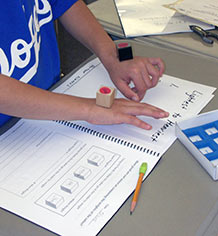
The investigation unfolds in two stages. In this first stage, pairs of students are challenged to order four cubes by felt weight, recording their observations in their notebooks on the page titled “How good are our senses at comparing the weights of the cubes?”
Students may handle the cubes in any way that aids comparison, perhaps holding one in each palm, or balancing one on the back of each hand, or holding them pincer–like, suspended from their fingers.
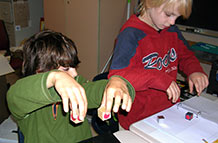
Circulate among the students as they work, offering encouragement. Perhaps they could try switching hands or closing their eyes.
The task is harder than it looks, and the students will have to work quickly, reaching consensus in about 10 minutes.
4. Order eight cubes by felt weight

In this second stage of the investigation, the two pairs work together to put all eight cubes in order by felt weight. When they have reached consensus, they record their ordering in their notebooks and answer the prompt at the bottom of the page, “I was surprised that … ”
When the group has finished, invite one member to record their order in the class table.
| Group | Least Weight → Most Weight | |||||||
|---|---|---|---|---|---|---|---|---|
| 1 | ||||||||
| 2 | ||||||||
| 3 | ||||||||
| 4 | ||||||||
| 5 | ||||||||
5. Make meaning
Purpose of the discussion
It is unlikely that every group will have placed the cubes in the same order. The investigation question, How good are our senses at comparing the weights of cubes? asks students to connect the investigation question with data, take a position, and identify data that support the claim.
Provide a few minutes for students to review the data table.
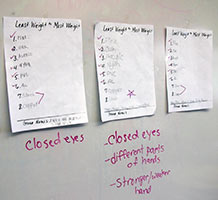
Engage students in the focus question
Remind students of the investigation question.
Students will have a sense that “felt weight” is subjective–after all, there were disagreements about the orderings. They will also have seen that as the weights of objects get closer, it gets harder to distinguish them by touch. But they don’t know yet how accurate their orderings might be. They are not demonstrated facts; they are predictions.
- How can we know for sure?
Let them brainstorm some ideas. If time permits, show them the pan balance and ask if anyone knows what it is or how to use it. Let them know that in the next session they will use this instrument to check the weight order of the cubes.
Be sure to save the class table for the next investigation.


